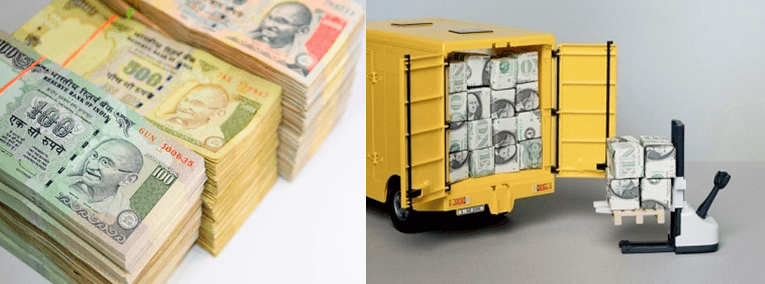Fleet Optimization, Last Mile Delivery Optimization
Effects of Demonetisation on Logistics Sector – Boon Or Bane
Nov 10, 2016
5 mins read
Demonetisation of 500 and 1000 Rupee notes- Boon Or Bane for the Logistics Sector?

While the western side of the world is undergoing a major political sea change, India has been stumped by a surprise currency ban. Indians struggled to pay for basic goods like food and fuel yesterday and fretted about their savings, after the government withdrew 500 and 1,000 rupee notes from circulation in a bid to flush out money hidden from the tax man. The big question now lies- Is India shifting towards a cashless economy, will it become a digital economy soon enough? And how demonetisation effects logistics industry which contributes to as high as 14.4% of India’s GDP (according to Novonous).
Almost 60 percent of the e-commerce retail happens on CoD basis in India. Most of the orders under the electronics and appliances category have an average value of Rs 4,500 and above. The payments for high value items are generally done through CoD.
As they say, there are always two sides to a ‘note’, let us evaluate the pros and cons of this humongous transformation in India to the logistics industry:
Demonetisation Cons:
- There will be a temporary effects of demonetisation on logistics for CoD, especially for the more expensive items.
- A huge number of delivery boys, drivers, warehouse loaders, who are dependent on weekly and monthly pays will be affected, especially in tier 2 and tier 3 cities.
- There is going to be a huge dry up of purchasing power.
- People will be more wary of making purchases online, due to their suspicion of fraud.
- There will be a risk of over-using credit cards to make online purchases. This leads to more debt, than one can handle.
Demonetisation Pros:
- Transparency increases, as value of goods will be very open, for example a cement company may sell cement to different vendors and different prices through cash transactions. The ban on black money will give better visibility to business (small and large equal)
- It has been observed that indirect cost of CoD services are much higher than direct costs due to large share of CoD transactions (as high as 60% by some estimates). This was making the whole business unviable for smaller players. Now smaller players will have a better chance of doing business.
- As CoD payment cycles varies from 20 to 45 days, it blocks significant capital for high volume websites. With a digital first approach, businesses will have a high working capital.
- One of the single biggest reason for delivery failures has been CoD. The reverse logistics arising from CoD defaults, returns can play havoc with the inventory costs as products must be examined and restocked. With that reducing, enterprises will see a drop in logistics costs as the rate of re-delivery will fall drastically.
- While India has an internet user base second only to China, only 14 per cent of the total internet users shop online in India, as compared to 30 to 35 per cent in Brazil and Russia, and 55 per cent in China. In the coming years, potentially 40 million shoppers in the age group of 19 to 24 years are expected to spend time and money online. This trend is rapidly aligning with e-commerce retailing, to facilitate the logistics sector’s growth.
- The agents handling delivery usually have a lot of cash to handle. A lot of security and legal formalities have to be done to protect companies from theft. With these changes, operations will be more efficient and quicker. The transaction time at the drop location will reduce significantly which will foster a higher number of orders being delivered on time.
In just one day, this abrupt step was fraught with problems for an economy largely fuelled by cash. However, on the digital front, there was positive movement, not significant enough to make predictions, but definitely showed an upward trend.
To validate this with numbers, Locus, a logistics automation platform, saw about a 11 percent increase in online orders of groceries and basic goods and a 12 percent increase in medicines that were ordered online and delivered to doorsteps.
While Locus did see an increase in number of orders, there was a small percentage of returns on the CoD orders due to unavailability of cash.
As a consumer, if you depend on small notes (which is the great majority of India) to pay for your groceries, household items — it could be difficult over the next one week to do so. It seems like, in the immediate term there is going to be a short downfall in movement of goods but with the increase in use of plastic money, we can see more transparency in the process of tracking goods. Management will be able to make quicker and better decisions leading to more business overall.
Some interesting facts:
According to the RBI press conference, there are 16.5 billion ‘500-rupee’ notes and 6.7 billion ‘1000-rupee’ notes in circulation right now. In addition to this, RBI data shows that the share of Rs 1,000 notes in the stock of currency in circulation at the end of financial year 2014–15 was 39%. Rs 500 notes accounted for a further 45% of currency stock. Putting it simply, a little over 80% of the cash in India (by value) will be worthless pieces of paper.
Stay tuned to Locus’ Blog to know how the banking logistics will be impacted with the ban of 500 and 1000 currency in India.
Like what you’re reading? Hit ❤ and follow us to read more.
Related Tags:

E-Commerce
Reverse Logistics : Forward Thinking Pays Big Dividends
“The line between disorder and order lies in logistics” — Sun Tzu, The Art of War Over the past few years, the global logistics industry has witnessed an increased interest in product returns, recovery, exchange and redistribution. Stats validate that 8 to 9 percent of goods purchased at brick and mortar stores and 25 to 30 percent […]
Read more
Dispatch Management
The Demonetisation impact over Banking Logistics
How are Banks going to solve the mighty challenge? The currency demonetization will go down as a revolutionary step in the books of Indian economy. But this revolution will come at a huge cost and pain to banks — they need to make the logistics work amidst the most challenging cash management exercises of all times. The […]
Read moreMOST POPULAR
EDITOR’S PICKS
SUBSCRIBE TO OUR NEWSLETTER
Stay up to date with the latest marketing, sales, and service tips and news


Effects of Demonetisation on Logistics Sector – Boon Or Bane